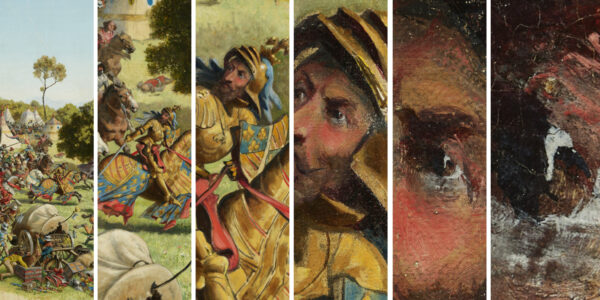From bunker to browser: The Murten Panorama reborn in terapixel resolution
Representation of the Terapixel Panorama in the interactive and augmented 360-degree environment (2025) © Laboratory for Experimental Museology, EPFL
On the anniversary of the Battle of Murten (22 June 1476), the Terapixel Panorama went live—restaging one of Switzerland’s most significant cultural treasures as a fully immersive, interactive digital experience. Captured using the Phase One iXH 150MP camera, the 1.6-trillion-pixel image now holds the world record as the largest digital image of a physical object ever created.
A masterpiece once hidden away in a Swiss Alps bunker is now viewable by the world—thanks to digital innovation, years of scholarly effort, and the image precision made possible by Phase One.
“With the Terapixel Panorama, we are not just preserving a national treasure—we are inviting the world to explore it in ways never before possible,” said Professor Sarah Kenderdine, Director of the EPFL Laboratory for Experimental Museology (eM+). “Phase One’s imaging precision was foundational in enabling this unprecedented level of detail and color accuracy.”
Detail of the photographic process for the Panorama of the Battle of Murten with a Phase One camera (2023) © Laboratory for Experimental Museology, EPFL
Digital preservation, elevated
The original painting, Panorama of the Battle of Murten, was created in 1893 by German artist Louis Braun. Measuring a monumental 10 x 100 meters, it was first exhibited in Zurich in 1894 and later in Geneva in 1907, before eventually being stored away for decades in a mountain bunker.
In 2022, the team at EPFL eM+, led by Prof. Kenderdine, embarked on the ambitious mission to digitize the entire 1,000m² canvas at 1,000ppi. Using a Phase One iXH camera paired with the 72mm MK II lens and a D8 R+ LED panel, the team captured ~26,000 ultra-high-resolution images, which were later stitched into a single terapixel file.
Representation of the Terapixel Panorama in the interactive and augmented 360-degree environment (2025) © Laboratory for Experimental Museology, EPFL
This setup ensured:
- Industrial-grade performance with zero dropped frames
- Even lighting across every frame through cross-polarization
- Exceptional sharpness and color fidelity, critical for stitching and scholarly research
The newly launched Terapixel interface allows users to:
- Zoom into the finest brushstrokes
- Follow motion-captured reenactments of medieval battles
- Explore embedded 3D artifacts and historical context
- Navigate with trilingual accessibility (EN, FR, DE)
- Engage through audio-descriptive tours for visually impaired users
The image fidelity delivered by Phase One is what makes this depth of experience possible. From rendering tiny period details to enabling scholarly annotation through IIIF manifest integration, it’s a benchmark in what cultural digitization can achieve.
Representation of the Terapixel Panorama in the interactive and augmented 360-degree environment (2025) © Laboratory for Experimental Museology, EPFL
From online to on tour
The digital twin is now set to travel the world. A series of fully interactive exhibitions is scheduled between 2025–2027 in Switzerland and abroad—including venues like the Museum für Gestaltung Zürich, Bernisches Historisches Museum, Castle of Grandson, Museum Murten, and Swissnex San Francisco. These multisensory showcases will bring the battle to life with sound, scent, and sight—rooted in the ultra-high-resolution master captured by Phase One.
Detail of the photographic process for the Panorama of the Battle of Murten with a Phase One camera (2023) © Laboratory for Experimental Museology, EPFL
A new standard in Heritage imaging
The Murten Panorama project is more than a preservation milestone—it’s a case study in what’s possible when academic vision meets imaging excellence. For Phase One, it’s yet another example of how our heritage imaging solutions are empowering institutions to digitize, preserve, and share the world’s cultural legacies like never before.
Explore the digital experience at terapixelpanorama.ch
Learn more about Phase One’s cultural heritage solutions at phaseone.com
Read the full case study about “Digitizing Panorama Formats with Phase One”.
Share this on social media:

